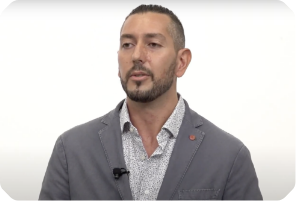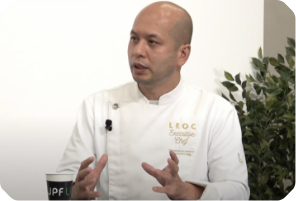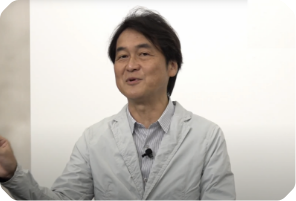Chefs, travel planners, and regional development specialists. Transcending countries and sectors to talk about Japanese food and food culture.
Japan’s diverse food and food culture has great potential as a key resource for Cool Japan. CJPF Live is one of the initiatives that explores the potential of Japanese food and food culture from diverse perspectives to realize branding for people around the world and to communicate the charms of Japan to people with various interests and preferences. On the first CJPF Live held on September 1, 2022, we welcomed guests from diverse sectors such as chefs, travel planners, regional development specialists, who work closely with Japanese food and food culture while sharing their activities and messages with the world. Below is a summary of the discussion about the charms and potential of Japanese food and food culture told by their own perspectives.
Discovering shojin cuisine.Communicating with ingredients.AI algorithms Developed by Chefs.
The first session was about the possibilities of Japanese food and food culture from foreign and Japanese pesrpectives. The main topics of discussion here was the potential of Japanese food and food culture.
Sara Millot is a regional development specialist working for the tourism association in Tsuruoka City in Yamagata Prefecture, which was designated as Japan’s first UNESCO Creative City of Gastronomy. She has begun working on an initiative to link shojin cuisine and other elements from the Dewa Sanzan sacred mountains with tourism activities. She says that there are three elements that will be attractive to visitors from any country: Authenticity (content with excellent taste and quality); Teaching (experiences that allow visitors to learn about history, culture, art, for example); and Researching (discovering content in line with the needs of modern society).
Alessandro Coviello, meanwhile, says that effective marketing is essential to getting Japan’s great food products to overseas. He also says that rather than well-known areas such as Tokyo, Osaka and Kyoto, he sees potential in Japan’s remote islands and rural areas. He himself is based in Hachijojima Island, and creates menus that link Italian cuisine with unique Japanese ingredients, such as Hachijojima Island Jersey milk, passion fruit, ashitaba herbs, and island-grown lemons. “Each ingredient of Japanese food has its own story so that it seems as if the ingredients are speaking to you. My mission is how to tell these stories,” he says.
“Social food gastronomy”—solving social issues and enriching future society through food. This is the philosophy of Hitoshi Sugiura, a chef working to open up various possibilities for food. With respect for the producers, he works around the world with a firm belief to share with the world the food that can only be eaten in this place, on this land, and in this area. Based on the idea of combining food with technology, he is also engaged in programming and developing AI algorithms. To date, his activities have had a major impact on Japanese food and food culture.

Growth through travel.Smart fisheries.Washoku archives.The future of food and food culture suggested by co-creation.
Again from the viewpoints of the foreign and Japanese participants, the theme for the second session was co-creation for the future started from food. Discussions in the second session centered on the topic of what new developments can we create with food as a starting point.
Paris-born Laetitia Da Costa, who has lived in Japan for nearly 17 years, says that Japan as a destination has a strong sense of exoticism, and that there are many things that visitors can learn. She describes visiting Japan as a Transformative Experience that allows the visitor to grow. According to her, “There are many food-related experiences in Japan, and these experiences themselves are exciting.” While emphasizing the link between food and culture, religion, customs, etc., her aim is to make Japan a Transformative Destination.
Aiming to digitalize Japan’s primary industries and production sites, so-called “Smart Fisheries”, Nemo Glassman has worked on the development of technologies for aquaculture and supply chain traceability. He says, “Japan has all the necessary content to lead the world in the future of food. I hope to play a proactive part in building futuristic supply chains, branding strategies for food ingredients, and more.”
Koichiro Shimura is a chef active in Japan and around the world who also hosts cooking classes, gives food education lectures, and participates in disaster relief activities. He has a strong ambition to “build a new food collaboration platform thinking from the restaurant industry that can lead to regional development.” The foundation of this ambition is a desire to communicate the appeals of food to as many people as possible. He talked about many interesting concepts, including “washoku archives”, “adapt and link”, and “the ultimate thing is human resources”.

Japan as a hub for cultural communication.
The first CJPF Live was full of fascinating discussions on Japanese food and food culture from diverse viewpoints, from which a number of interesting ideas emerged.
Participating in this CJPF Live helped me to realize that, as a nation, we in Japan have forgotten the quality and appeals of our own country. Japan has four unique seasons, and it could be said that Japan has four times as much potential for “spring, summer, fall, and winter” compared to the rest of the world. There still is plenty of potential in Japanese food and food culture , including seasonal marketing and rediscovering local cuisine.
The role of CJPF is to develop the activities of each of these individuals as a “dot” into something much bigger as a “surface”. Up until now, Japan has predominantly been seen as a nation of manufacturing, but this CJPF Live has demonstrated the potential for Japan to become a hub for cultural communication through food-based co-creation.
The two sessions led to a range of new discoveries and possibilities.

登壇者プロフィール
-

Alessandro Coviello
Marketing supervisor at Barilla Japan and TV chef
Alessandro Coviello was born in Italy and is a graduate of the University of Venice. He came to Japan to study Japanese while in university. Later, he worked as a chef while employed at a company importing high-quality mozzarella cheese and prosciutto from Italy. Between 2016 and 2017, he appeared on TV as a food researcher. He has also held foreign cuisine classes featured in magazines, and held cooking demonstrations at international exhibitions. Today he works as a marketing supervisor for Barilla Japan while working as a chef in Hachijojima Island. He also creates menus that fuse Japanese and Italian cuisine using ingredients from the island. -

Sara Millot
Regional development specialist at Tsuruoka City Tourism Association
A native of France, Sara Millot graduated from the department of Japanese language at the University of Toulouse, before studying at Waseda University. In 2017, she came to Japan again as a coordinator for international relations at Tsuruoka City in Yamagata Prefecture, and was assigned to the tourism and products division. Since 2020 she has been in charge of developing travel products and providing tourism information as a chief of the DEGAM Tsuruoka Tourism Bureau Business Section. In 2018 she coordinated a collaborative project between Niigata City and Tsuruoka City for the Japonismes event held in Paris, while in 2020 she acted as a consultant for The Grand Dewa Route Project. She is also engaged in a wide range of other inbound-related activities, such as training English-Japanese and English-French tour guides and developing adventure tourism products for Tsuruoka City. -

Hitoshi Sugiura
Group Executive, Onodera Group
Born in Osaka, Hitoshi Sugiura moved to the U.S. in 2009. There, he refined his sensibilities and acquired various skills at Michelin-starred restaurants in Los Angeles and New York under James Beard Foundation award-winning chef Joachim Splichal . For two consecutive years from 2014, he served as Japanese representative chef for a reception party of the Japanese Delegation to the United Nations held at the United Nations Ambassador’s Residence in NYC. Using his international food experience, he is currently a leading authority on vegan and plant-based cuisine in Japan. He is also the recipient of numerous awards. He is currently a firm advocate of “Social Food Gastronomy,” and develops social contribution and innovation on the international stage by using his diverse perspectives. -

Laetitia Da Costa
Experience Manager, Japan Experience
Laetitia Da Costa was born in France and came to Japan on an exchange scheme between a school in Paris and Japan. Although she once returned to France, her interest in Japan remained, and she re-enrolled and graduated from Keio University. After working in Tokyo in advertising, art curation, translation and interpreting, she joined Japan Experience, a travel agency with its head office in France, in 2011. As a founding member of the Japan branch, she was in charge of building partnerships with locals and developing new products, and was appointed product manager. In 2022 she acquired a qualification in experience design. Using her extensive experience and global outlook, Da Costa is designing the value of Japan’s tangible and intangible assets. -

Nemo Glassman
CEO Food Tech Trading CEO Sea Tech Trading
Born in the U.S., Nemo Glassman graduated from Willamette University and came to Japan in 2002 as part of the JET Program, taking residence in Saga Prefecture. In 2010, he set up Plus Alpha Japan in Kyoto, a company provides events and Japanese content for foreign tourists on an introductory basis. In 2019, he established Sea Tech Trading, implementing a primary industry digitalization project with the Fisheries Agency, and in 2021 he set up Food Tech Trading. Working with the Japanese government, Japanese food manufacturers, major Japanese corporations, and major IT companies in the U.S., he is promoting the digitalization of Japan’s primary industries and supply chains, and working to reform export operations. -

Koichiro Shimura
Owner, Tempura Ono
Koichiro Shimura took over as the second generation owner of Tempura Ono in 2006. Since then, he has been serving his own, unique style of tempura for predominantly VIP guests from overseas. While working as an international chef, he has also visited Yamagata Prefecture, Hokkaido, and other areas to strengthen his relationships with producers. He is also involved in various activities, such as lecturing at Waseda University and International Christian University, and taking charge of supervising Japanese cuisine on world cruise ships. In 2016, he was appointed as a Cool Japan regional producer. During the pandemic, he focused his efforts on Shimura Department Store activities, which connects producers nationwide with consumers. In July 2020, he opened his second restaurant Tenne Shimura Masa in Ginza. -

Takeshi Natsuno
Special Visiting Professor and Director of the Cyber Informatics Research Institute, Kindai University; President and Member of the Board, KADOKAWA Corporation
After graduating from the School of Political Science and Economics at Waseda University, Takeshi Natsuno joined Tokyo Gas. He later acquired an MBA from the Wharton School of Business of the University of Pennsylvania. Following a stint as vice-president of a startup company, he joined NTT Docomo. Here he launched an array of services including i-mode and Osaifu-Keitai, and served as an executive officer of Docomo. Currently, in addition to being a special visiting professor at Kindai University, he also serves as president of KADOKAWA, president of Dwango Co., Ltd., and as an outside director of a number of companies. He also acts as Chairman of the Council for Promoting Regulatory Reform of the Cabinet Office, and has participated in various governmental committees. -

Kenichi Watanabe
Director, Cool Japan Public-Private Partnership Platform Value Designer, XPJP Inc.
Born in Tochigi City in Tochigi Prefecture, Kenichi Watanabe graduated from Gakushuin University before joining KDDI and the Asahi Shimbun Company. He went on to study social media marketing and media strategy at the University of California San Diego and international business at the University of Washington. He returned to the Asahi Shimbun Company after returning to Japan, and worked on a collaborative project with the Japanese government. In 2008, he was then dispatched to the Office for the Promotion of Regional Revitalization at the Cabinet Secretariat. He established the regional production company Genki Japan in 2010, the public-private social production company XPJP in 2015, and a space design company Space SAGA in 2021. He currently develops a range of collaborative projects nationwide with governments, businesses, media outlets, and citizens across Japan. He also serves as a visiting professor at the Kyoto University of the Arts, a visiting professor at the Tohoku University of Art and Design, and a researcher at the Graduate School of System Design and Management at Keio University. One of his hobbies is playing lacrosse.






Questions and comments for CJPF Live Greetings in line with the 1st CJPF Live
Takeshi Natsuno
Co-chairman, Cool Japan Public-Private Partnership Platform Special Visiting Professor; Director of the Cyber Informatics Research Institute, Kindai University President and Member of the Board, KADOKAWA Corporation
Hello, everyone. My name is Takeshi Natsuno and I’m the co-chairman of the Cool Japan Public-Private Partnership Platform. Thank you all for watching CJPF Live. Cool Japan activities aim to attract Japan’s fans by providing a rich variety of “entrances”, including anime and food, and communicating the “depth” of history and culture behind them. To increase the number of Japan’s fans, it’s essential to continue to refine the “entrance” and “depth” and create new Japan attractions. To do so, it will also be important to match people involved in Cool Japan who have a variety of ideas. In the Cool Japan Matching Awards held in July this year, the Grand Prix award was given to a competitive shooting game held in a space of the recreation of Nijo Castle in Kyoto. Other wide-ranging matchings included Japanese sweets and a subscription service, Kabuki and Hatsune Miku, have also created new value. Since last year, the Cool Japan Public-Private Partnership Platform has been engaged in activities starting with food and food culture. Japan’s food and food culture is rooted in the diverse natural surroundings and climate of each region, and have diverse points of contact from ingredient producers and chefs to tableware and etiquette culture, the restaurant industry, technology, and more. Moving forward, ahead of the full relaunch of inbound tourism, it will be important to expand our matching activities starting from food and food culture, and refine it as unique and attractive content while shining a light on various regions in Japan. The main topic for CJPF Live, which will be held for the first time, is the possibility of Japanese food and food culture. The aim is to create unprecedented new matching by inviting people active on the frontlines of Cool Japan activities, and discussing interactively also with the audience. This time we will discuss the future of Japanese food and food culture discovered from domestic and international perspectives. Future CJPF Live sessions are scheduled to discuss about matching between Japanese food and food culture and “new food and food culture emerging from the region and dissemination”, “regional luxury tourism”, “digital and data” and so on. We hope you will look forward to it. To finish, I sincerely hope that the new Japanese attractions based on food and food culture will be emerged by this CJPF Live and that this will lead to Expo 2025 Osaka, Kansai.